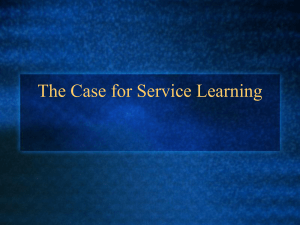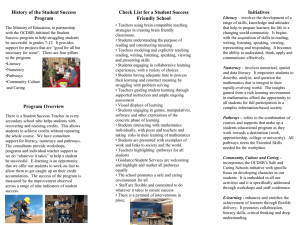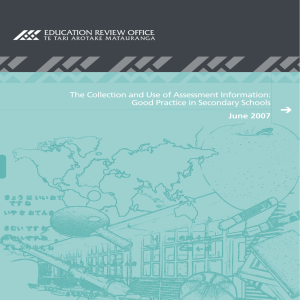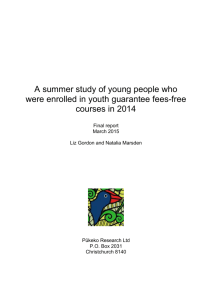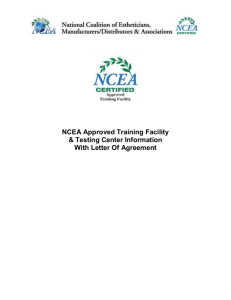Full report (PowerPoint 90 kB)
advertisement
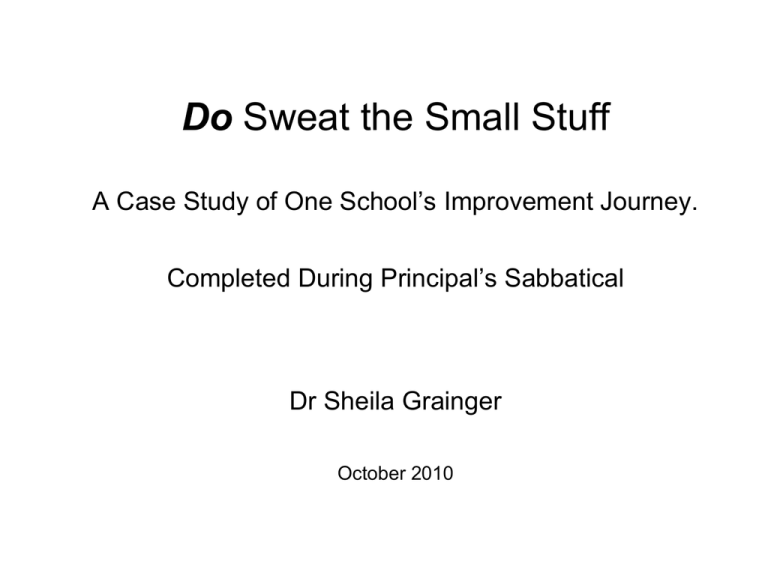
Do Sweat the Small Stuff A Case Study of One School’s Improvement Journey. Completed During Principal’s Sabbatical Dr Sheila Grainger October 2010 Notes • This is a powerpoint summary of a 41 page paper prepared during the Principal Sabbatical of Dr Sheila Grainger • The full paper is being prepared for publication in a relevant academic journal • For further information email Sheila.grainger@buller.ac.nz History • Serious concerns about the school’s performance began to be identified by the Education Review Office (ERO) in 1992, finally leading to statutory intervention in December 2005. • Rapid change and improvement characterised the statutory intervention period, and by December 2009, the statutory intervention was withdrawn and the school returned to a “normal” 3 year cycle of ERO monitoring. • In 2009, the ERO team talked about the “turn around” of the school, and their questions led the school’s leadership to reflect on how this had been achieved Sustainable Improvement • Fullan, 2006, reports that many school turnarounds have been short-lived. The problem with many turnaround strategies he says, is that they focus on external interventions. He says current turnaround policies and practices generally move schools from awful to adequate but no further, failing to achieve long-term sustainable improvement. • Fullan, M. (2006). Turnaround leadership. San Francisco: Jersey-Bass. Key to Sustainability • As long as school decision making continues to be based on shared understandings about valued student outcomes, and has the tools to ensure its decision making and strategic planning is informed by evidence of student achievement, progress should be maintained. • The key to its sustainability lies in the leadership of the school aligning its decision making to the values it wants to promote, and ensuring that every decision it makes, however small, consistently reflects those values. Examples of Sustainablity • • • • Pathways Department Provison for the Less Academic Study Periods Classroom Behaviour and Student Work Pathways Department • there were no shared understandings amongst stakeholders, of how career education could make a huge difference in students’ lives, lifting their expectations and bridging the gap between their limited view of their future and the potential they could aspire to. • This lack of shared understandings about what counted as valued student outcomes in terms of career planning and course selection, created a vacuum into which teacher centric and timetable centric considerations could creep, allowing school decision making to be subverted. One example of this, the shortened English and Maths courses at year 11, is discussed in detail below. Pathways Department • The Department’s brief is to connect students to their future potential right from year 9, and find innovative ways of helping students to set and review their career goals, making informed choices about study pathways as they progress through school. • The Head of Pathways tracks credits attained and still needed by students; co-ordinates STAR Gateway and Distance Learning provision; enrols students in interest rich courses which broaden their horizons; and develops individualised pathways for students who do not thrive in traditional academic subjects. • The valued student outcomes achieved through the pathways approach include, enhanced student expectations, a wider range of student achievements with more students succeeding and enhanced targeting of school resources where the need for extra student support is identified. • Provision for the Less Academic • Those in year 11 with the lowest skills in literacy and numeracy were channelled into an alternative class which provided 2 terms tuition in alternative maths and 2 terms tuition in alternative English, instead of 4 terms in each. • In this way, those students most needing to improve in these two essential learning areas, received only half the standard tuition time enjoyed by other students. Provision for the Less Academic Increased value added in NCEA English CEM Englis h vs NCEA Le ve l 1 Englis h pas s Rate s 80 Dip in value added in 2009 NCEA English 70 60 50 English 40 NCEA L1 30 BUT still high literacy attainment. = 20 10 The need to more closely interrogate our student achievement data in NCEA Level 1 English. 0 2004 2005 2006 2007 Year 9 Intake Level One Literacy Final Results 2009 Final 100 80 60 % L1 Literacy BHS L1 Literacy Nat 40 L1 Literacy Decile 3 20 0 2003 2004 2005 2006 2007 2008 2009 L1 Literacy BHS 55.8 64.3 63.5 57.8 75 90.9 78.8 L1 Literacy Nat 70.6 69.9 72.5 75.2 76.7 77.3 77.6 L1 Literacy Decile 3 58.5 60.6 66.3 69.6 71.8 74.8 74.8 Year Identified the need for more focus on preparation for the NCEA external assessments in English. English programme revamped to ensure that the pursuit of the 8 Level 1 literacy credits is not at the expense of achievement in the externals. Study Periods • ERO reports since 1992, had commented on inconsistent attendance and absence monitoring, lack of student engagement, poor quality and organisation of student work, low achievement and low teacher expectations. • These, coupled with environmental factors, such as the low value which some sectors of the community traditionally placed on academic study and schooling, were all contra indications for exempting these students from attending school during their study periods. • It was, in fact, a management centric solution to the problem of what to do with students during those times, and the school had by default absolved itself of responsibility for them. Study Periods • Since a more student centric approach has been taken, with the staffing and monitoring of a study room where all seniors must spend their study time, senior attendance and work ethic has improved. • The expectation of regular supervised study has improved the learning culture both for seniors and, through their modelling, for junior students. Classroom Behaviour and Student Work • Successive ERO reports had reported poor quality and disorganised work in many classes in the junior school. • My own observations in classrooms during term one 2008 confirmed that in many junior classes teacher expectations were low and student work was low in quantity and quality. • Many exercise books were marred by graffiti, sexual innuendo and scrappy pages, with set tasks often at a low level, failing to challenge students. • In many students’ books there was a striking lack of teacher feedback and feedforward on their work, and little evidence that teachers were valuing students’ work and passing on that sense of value to students. • Storage of students’ books in some classes was disorganised and counter productive to the valuing and tracking of student work to monitor progress and guide students’ next learning steps. Classroom Behaviour and Student Work • School wide professional development sessions on the Best Evidence Synthesis on Teaching and Learning (Robinson, Hohepa, & Lloyd, 2009) • Sessions on student data showing how few students were actually “below average” and how many were well above on their entry data • Checking all junior student work in the four core subjects English, Social Studies, Maths and Science on a regular basis • Increased monitoring of credit attainment and analysis of NCEA results in the senior school • Written feedback to teachers and their HODs on the quality of work observed, with any requests for improvement rigorously followed up with the department concerned. • School wide professional development sessions addressed the importance of teacher expectations and the use of student data in planning • School targets reflected the desired quality of work • Principal reports to the Board of Trustees. • Student “buy in” Classroom Behaviour and Student Work Total Timeouts as at end of Term Three 2010 2500 2000 1500 1000 500 0 Totals 2001 2002 2003 2004 2005 2006 2007 2008 2009 2010 1504 1265 1498 1218 2050 1583 932 715 712 594 Learning From Reflection • Shared understandings of school purpose and what constitutes valued student outcomes need to be established in order to successfully drive school decision making and school improvement • An evidence base of valued student outcomes needs to be established and constantly interrogated for monitoring and tracking progress so that decision making can be student centric not teacher or management centric • Tools for self review and self improvement need to be accepted and embraced by all staff, so that a culture of high accountability can sit comfortably with a culture of high professional trust • School leaders do make a significant contribution to school improvement and success but this would be unsustainable without the support of a skilled management team. On the other hand, school leaders can also pose the biggest risk to school success and early identification of this risk could avoid school failure. Learning From Reflection • Where problems are repeatedly identified at both school governance and management levels personnel changes at one or both of these levels are probably needed before school improvement can begin • The highly complex work which principals do is enacted through a chain of tasks which are often mundane and trivial, but each one offers the opportunity to pursue the strategic change agenda and embed shared understandings about valued student outcomes • Educational change often needs to be achieved through “sweating the small stuff” because the small stuff is what dominates a principal’s day, and there may never be a time when only the “big stuff” can be addressed Conclusion Teachers and Leaders can make a difference.






